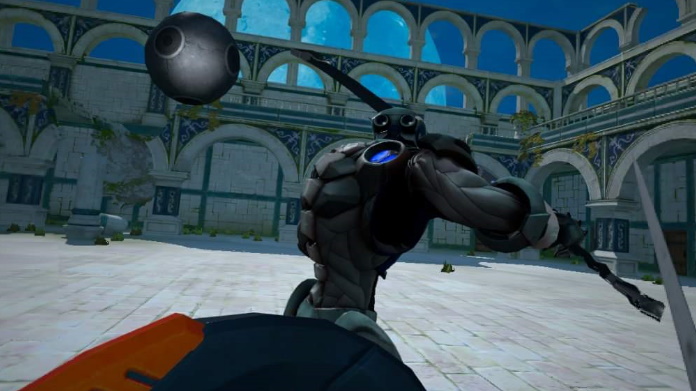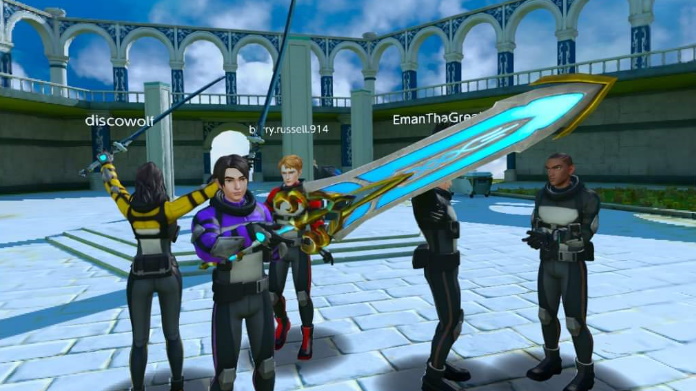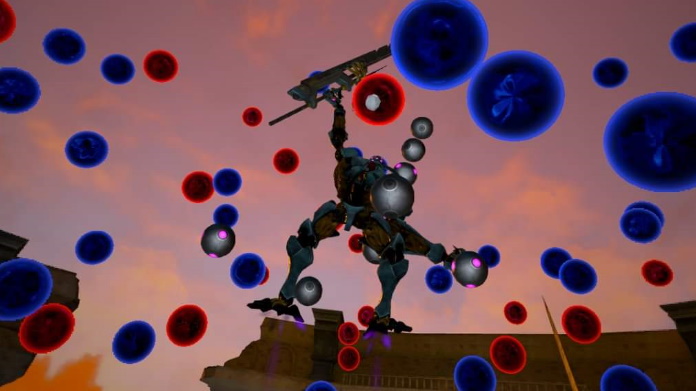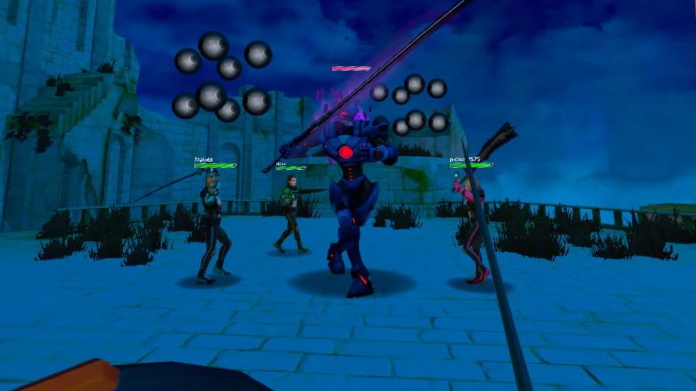
One of the best things I’ve experienced in VR gaming has been swordfighting. Sure, waving a controller around to translate it into sword strikes isn’t precisely novel in gaming thanks to the Wii, but doing it in virtual reality can very often feel a lot more impactful owing to the first-person view, the three dimensional play space of VR, and the spatial awareness that feels unique to the games medium. This kind of game experience is, quite simply, custom-built for VR.
So when I heard about Altair Breaker, a multiplayer co-op game all about hacking and slashing robots, it sounded right up my alley. I was even more intrigued when I was granted a review copy from developer Thirdverse. Unfortunately, my excitement began to get melted by the actual experience of playing the game itself. Altair Breaker has managed to mess up a kind of play experience that I had thought was impossible to do.
Altair puts you in a series of rooms and tries to call itself a world and tries to make you care about some glass-eyed avatar that just stands there and spouts exposition the first time you approach her. The main hub is, predictably, where most of the downtime happens, with access to some shops, storage chests, and terminals to fire up the main crux of the game. It doesn’t really have much else going for it and kind of felt unfinished and underwhelming.

That ended up being appropriate considering the actual gameplay itself felt similarly unfinished and underwhelming. The act of sword swinging worked fine enough and certainly mapped my movements accurately, but the actual sensation of fighting enemies was severely lacking in terms of hit detection and maneuvering. Robotic foes, no matter their size, all felt like they has much smaller hitboxes than their models would suggest, which is pretty important in a game where it’s all about melee combat. Similarly, nearly every sword I used made me suspect its hurtbox was far smaller and shorter than its model would have me believe; the only weapons that felt appropriate size-wise were the two-handed weapons.
This is a a big problem when you’re rewarded less for precision and more for fast action. There are some cool moves that can be pulled off, such as knocking a foe into the air and zipping up to them to slash away at them before they land, but all of these neat moves never felt great to pull off owing to the aforementioned issues.
Shallow swords and small robot striking points aside, the enemies themselves felt half-baked in terms of their attack patterns. In the hours I played, I have encountered only three types of enemies: melee sword swingers, robots that are armed with bullet hell-spitting ranged attacking drones, and one very large boss at the end of the five or so levels that combat moved me through. There wasn’t any sense of variance, there weren’t any distinctive features, and there wasn’t a whole lot of personality in their design or their mannerisms. The only thing that makes these cookie cutter foes stand out is their general size differences and the kinds of bullet hell attack patterns they fire, which all seem to be randomly plastered on any number of bots.

This lackadaisical design would have been reasonable enough to put aside except that the robots’ movements are also completely weird and janky. Most of the time they move like they’re wading through molasses, telegraphing the hell out of most strikes, except for when you try to close melee distance – again, the entire crux of combat in Altair – at which point the bots just sort of errantly and swiftly duck back just out of range of your swings like some cheap, input-reading fighting game AI foe. There is a forward dash move to try to close distance swiftly, which is done by a double-flick of an analog stick, but that more often than not never went off correctly. And no, there’s no way to remap the controls.
Furthermore, the game frequently felt buggy. More often than not, robots would idiotically leap backwards off of a stage. Or they would dart around rapidly if the part of the level they were on was too small. Or they would get stuck on some of the level’s geometry. Or they would refuse to come down to me, waiting for me to try and swing so they could read my input and just backstep out of the way. Or off of the stage. Or into the geometry. You get the picture.
To top it all off, every gameplay session is precisely the same. You move through five or six stages, hoping that an enemy spawns with one of the four gate cubes needed to move to a final boss arena, you beat on a really big (and similarly buggy) giant robot, and that’s it. That’s literally the entirety of the gameplay. No different stages. No different enemies. Nothing. Sure, there’s the chance that you’ll find a neat weapon type that you can power up and there’s some leveling up of stats for your avatar, but that requires a lot of materials from the same boring routine of unsatisfying gameplay.

I also would be remiss if I didn’t point out the abhorrent lack of quality-of-life features. You cannot change your equipment in the middle of a level, potions don’t stack for some absolutely insane reason, and inventory space is hilariously limited and impossible to expand, as far as I’m aware. The only way you can actually swap out your equipment is if you go to a camp in-between levels, and nine times out of 10, most of the teams I ran with don’t bother to.
On the subject of playing with others, that helped to alleviate some of this misery (since misery loves company), but that of course can be a crapshoot in terms of whom you play with in a PUG. That’s not to suggest that the people I’ve fought alongside have been awful; as a matter of fact, they’ve been surprisingly tame considering this game has open voice chat from the jump.
What I’m referring to instead is the power discrepancy that often makes going through stages feel unfulfilling; very frequently I was in teams with players who probably have jacked up their weapons and stats to a fair degree, with no matchmaking consideration to my own meager power levels. And considering that earning XP is kind of dependent on personal performance, it makes a long slog feel even longer when your teammates slice things to ribbons.

Overall, Altair Breaker needs a lot done to make it feel complete, and that’s a big ask as this is a fully launched title, not an early access test phase. Fast-paced action means almost nothing when weapons and foes feel off and there’s barely any motivation to play repeatedly. I have to admit, though, this game has managed to surprise me in that an obvious form of VR gaming was executed so phenomenally badly.
 Sometimes you need a break from the real world and have to take some time on the holodeck, and so do we! Tales from the Holodeck is where Chris Neal and the MOP team report on virtual reality gaming and related topics as well as more “traditional” sandbox MMOs that seek to create full worlds to get lost in.
Sometimes you need a break from the real world and have to take some time on the holodeck, and so do we! Tales from the Holodeck is where Chris Neal and the MOP team report on virtual reality gaming and related topics as well as more “traditional” sandbox MMOs that seek to create full worlds to get lost in.














